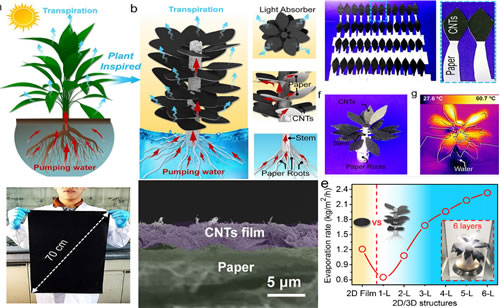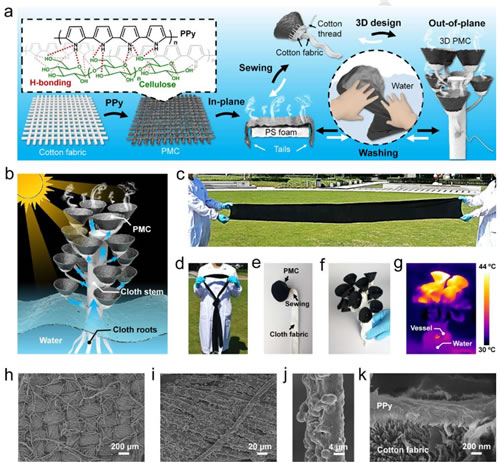Water shortage is a global problem facing us now. Desalination of the abundant seawater on the planet is an important way to solve the problem of water shortage. However, traditional seawater desalination often requires high energy consumption, which is difficult to achieve in some energy-shortage areas. Therefore, a green, efficient, and sustainable seawater desalination method is urgently needed to alleviate the above-mentioned crisis. Sunlight-driven interface light hot water evaporation, because it can purify seawater by generating steam at a temperature much lower than the boiling temperature of water, has attracted more and more attention in the past few years. However, at present, most of the photothermal purification is concentrated on the two-dimensional (2D) interface vaporization platform, which has the problems of low three-dimensional space utilization efficiency and high heat loss. Therefore, in a limited system, constructing a 2D light absorber unit into a three-dimensional (3D) frame is considered to be one of the most direct and effective ways to improve the collection capacity of purified water.
Based on a capillary force induced extrusion of water-air interface developed in the early stage, the team of Chen Tao, a researcher from Ningbo Institute of Materials Technology and Engineering, Chinese Academy of Sciences, constructed a large-area, arbitrarily transferable carbon nanotube film method (Chem. Mater. 2016, 28, 7125; ACS Nano 2019, 13, 4, 4368-4378), recently, the team used capillary force transfer method to in-situ composite carbon nanotube film and commercial printing paper on the water-air interface to construct a A flexible, tailorable and patternable asymmetric carbon nanotube composite paper. Inspired by the structure of trees in nature, trees can grow in three dimensions and have layered leaves and roots to enhance transpiration. The researchers further tailored this patterned asymmetric carbon paper, Assemble a 3D tree structure and apply it to light and hot water purification (see Figure 1). It was found that this 3D tree structure photothermal evaporator has a stronger light and hot water evaporation capacity than the 2D planar structure, and its seawater purification capacity can reach 2.38kg / m2 / h (Solar RRL2019, DOI: 10.1002 /solr.201900004).
However, when in an unrestricted system, 2D structures sometimes have a greater advantage than 3D structures. Therefore, how to simply and quickly realize the conversion of the 2D / 3D structure of the photothermal evaporator to adapt to different environments still faces challenges. The team obtained polypyrrole hybrid paper (PPyP) by in-situ oxidative polymerization of pyrrole monomer on the surface of cellulose paper, and used the coordinated control of PPyP micro / macro level to achieve the best light and hot water purification speed. Compared with the traditional fixed 3D structure, the PPyP can realize the mutual switching of 2D / 3D structures (as shown in Figure 2), and has good switching stability, so that it can better adapt to different application environments (ACS Appl. Mater . Inter. 2019, 11, 15498-15506).
Based on the above research, recently, researchers have prepared a low-cost, large-area, mechanically stable, washable and sewable polypyrrole cotton cloth (PCM) by controlled oxidation and polymerization of pyrrole monomer on the surface of cotton fabrics. , As shown in Figure 3). Surprisingly, this photothermal fabric is produced by a wet method, which shows its potential for large-scale production, and the cost is as low as about 2 dollars / m2, and it has a very strong commercial competitiveness. Subsequently, inspired by the plant's water absorption, transpiration behavior and its multi-level structure, combined with the unique cutability and sewability of the fabric, a 3D "plant" with a multi-level structure was obtained, achieving an efficient " out-of-plane "photothermal evaporation. Under the intensity of a sun, in a laboratory environment, this 3D PCM can achieve a maximum sea water purification speed of 3.37kg / m2 / h. In addition, the photothermal evaporator has a strong salt drainage performance, which can diffuse the salt accumulated during the day into the water phase through the rich capillary channels in the PCM at night, thereby ensuring its long-term stable use. In outdoor experiments, under cloudy weather, the 3D PCM can purify about 5.39kg of seawater per square meter in 7 hours, and can directly meet the WHO drinking standard (removal rate of various salt ions is maintained above 99.9%). More interestingly, the 3D PCM-based photothermal evaporator can even purify seawater or other non-potable water from solid substrates (sand, etc.), showing its huge application potential under certain extreme conditions. Related work was recently published in Nano Energy 2019, DOI: 10.1016 / j.nanoen.2019.104002.
The above work was supported by the National Natural Science Foundation of China (51803226, 51573203), the Chinese Academy of Sciences Frontier Science Key Research Project (QYZDB-SSW-SLH036), the Postdoctoral Innovative Talent Support Program (BX20180321), the China Postdoctoral Science Foundation (2018M630695), and the Ningbo Science and Technology Bureau (2018A610108 ) Waiting for funding.

Figure 1 3D tree structure photothermal evaporator design and photothermal evaporation performance

Figure 2 2D / 3D PPyP switching

Figure 3 Low-cost, large-area, high mechanical stability, washable and sewnable polypyrrole cotton cloth for seawater desalination
3Ply Face Mask, Disposable 3ply Face Mask,Non-Woven 3ply Face Mask,3ply Face Mask with Ear Loop
Ningbo Jiashang textile co., LTD., , https://www.cn-jshang.com